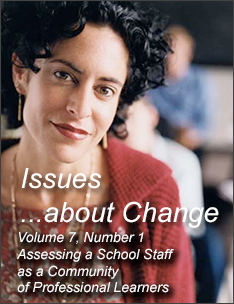Assessing a School Staff as a Community of Professional Learners
Introduction
For decades schools have been urged to engage in change and improvement activities. In the seventies, research on effective schools and on the process through which to achieve them was on "improvers" minds. In the eighties, the principal came under scrutiny for the role that a person in this position could play in school change efforts. In succession came attention to restructuring, school-based management, total quality management, and a myriad of additional programs and processes that were offered to schools to support their improvement efforts.
The Southwest Educational Development Laboratory (SEDL), like many of the ten regional laboratories, invested staff and resources in studying and supporting schools in their efforts to improve their effectiveness so that students might become more successful learners. In the process of conducting studies that examined leadership strategies and contextual factors that might influence school change, SEDL researchers discovered a school whose staff worked together in a way that was very different from that of the typical school. This school became the target of intense exploration for three years (Hord & Boyd, 1995).
This school staff's vision and continuous conversation focused on students and student learning. Beginning in the early 1980s the staff came together regularly and frequently to reflect, inquire into what they were doing and how they were doing it, and assess whether their work was producing the results they wanted for students. They brought new ideas for programs and practices that would support their work with students, and they committed to learning new strategies and content to this end.
In short, they were a staff who collectively searched for ways to become more effective teachers, who valued changing their own knowledge base and skills, and who sought change to accomplish improvement. The staff pursued these strategies through a decade and a half and a succession of four principals.
New Ideas
In 1990, Peter Senge's Fifth Discipline swept boardrooms in the private sector and, subsequently, school boards in education settings. Senge's book promoted the idea of a work environment where employees engaged as teams, developing a shared vision to guide their work, operating collaboratively to produce a better product, and evaluating their output.
Simultaneously, Susan Rosenholtz (1989) published ideas from her research that described a workplace for teachers that encouraged collaboration, an environment in which teachers shared ideas and solutions to problems, and shared learning about educational practice. Importantly, she found that as teachers learned from each other and improved their practice, benefits to students increased.
The convergence of these literatures and the research that was being done in the school noted above led an R&D team at SEDL to design new work that would focus on creating and nurturing the kind of workplace and culture in schools that Senge, Rosenholtz, and Hord and Boyd had identified — a workplace where students and learning were the undeviating focus and the staff worked collegially to achieve the desired results.
SEDL's Work
The first phase of SEDL's new work, Creating Communities of Continuous Inquiry and Improvement (CCCII), was initiated by a review of the literature to reveal what was already known about school staffs that worked in this way. The review was quite brief, since the knowledge base that focused on "professional learning communities" (PLC) or "communities of inquiry" (and we have used these terms interchangeably in our work) was in its infancy. As Linda Darling-Hammond reported (1996), schools that operated in this way are few and far between.
The literature described these organizational arrangements in schools, providing useful insights into what they looked like and how they worked, with the SEDL research school (noted above) viewed as being parallel to the literature descriptions. The literature also contained information about student gains that resulted when staff worked as a professional learning community. What was not in the literature was how the school's administrators and teachers created or invented this way of working with each other.
With the information derived from the literature, the SEDL researchers set out to find additional schools in the laboratory's five-state region (Arkansas, Louisiana, New Mexico, Oklahoma, and Texas) that operated as communities of inquiry. The researchers felt that historical studies of these schools would reveal how they had become communities of inquirers and learners.
An immediate issue was how to identify such schools. Colleagues across the five states had been asked to nominate schools for study, but this kind of school was far too unusual to be easily identified. Schools were enthusiastically nominated, but proved disappointingly inauthentic when examined. What to do?
Next Page: Evolution of an Instrument

